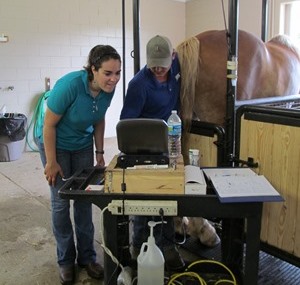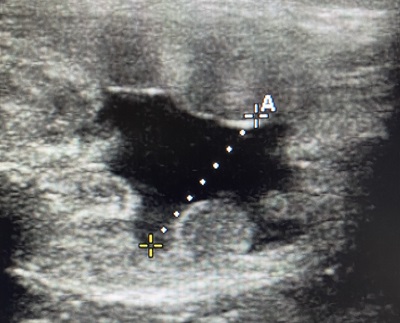Breeding Strategies for Mares Inseminated with Frozen Semen
March 21, 2022
Posted by
Paul Loomis in
Breeding With Frozen Semen
 Timed artificial insemination (AI), programmed AI, one dose, two doses, deep horn insemination…what’s best for your mare? With the increased use of frozen semen and the trend towards commodity sales (by the dose with no guarantee) veterinarians have developed a variety of strategies when managing mares being bred with frozen semen. In this article, we discuss several options and which ones might be most appropriate for your situation.
Timed artificial insemination (AI), programmed AI, one dose, two doses, deep horn insemination…what’s best for your mare? With the increased use of frozen semen and the trend towards commodity sales (by the dose with no guarantee) veterinarians have developed a variety of strategies when managing mares being bred with frozen semen. In this article, we discuss several options and which ones might be most appropriate for your situation.
Influence of Mare Status When Breeding With Frozen Semen
January 08, 2016
Posted by
Dr. Sandro Barbacini in
Breeding with Frozen Semen
 Whether a mare is maiden, recently foaled, or barren can influence her ability to conceive when breeding her with frozen semen. The first pregnancy obtained by using frozen-thawed semen in the equine species dates back to 1957 and was obtained using epididymal semen. However, for many years this reproductive technology has achieved limited progress in the horse compared with other species such as cattle. This was mainly because for a very long period of time only a few horse registries allowed the use of frozen-thawed semen. Hence, economic interests and resources allocated to research have always been minimal and as a result obstructing advances in this area.
Whether a mare is maiden, recently foaled, or barren can influence her ability to conceive when breeding her with frozen semen. The first pregnancy obtained by using frozen-thawed semen in the equine species dates back to 1957 and was obtained using epididymal semen. However, for many years this reproductive technology has achieved limited progress in the horse compared with other species such as cattle. This was mainly because for a very long period of time only a few horse registries allowed the use of frozen-thawed semen. Hence, economic interests and resources allocated to research have always been minimal and as a result obstructing advances in this area.
Splitting Doses of Frozen Semen
May 06, 2014
Posted by
Paul Loomis in
Breeding With Frozen Semen
“I just purchased one very expensive dose of frozen semen from this incredible stallion. Is it OK to split the dose and breed two mares to try and get two foals?” or “The stallion owner only provides one dose per heat cycle and my vet would like to use a timed insemination protocol. Is it OK to split the dose and inseminate twice on the heat cycle?” At SBS we have heard these questions or some variation of them many times over the years. The answers are not simple ones. This blog article will follow up on two previous blogs that are also important in understanding the issue. See the recent blogs What Exactly is a Dose of Frozen Semen? and What is Progressive Motility?
The Pros and Cons of 1 or 2 Dose Insemination Protocols
February 16, 2012
Posted by
Dr. Sandro Barbacini in
Breeding With Frozen Semen
It is a common belief of many veterinarians and breeders that the
lifespan of frozen semen within the mare’s reproductive tract is reduced
compared to fresh semen. While no experimental fertility trials
have been conducted to directly address this question the type of damage
that can occur to sperm membranes during the freezing and thawing
process theoretically could reduce the longevity of semen. Sperm binding
to the lining of the oviduct can extend fertilizing capacity in the
mare and there is in vitro evidence that frozen-thawed sperm do not
bind as well to the oviductal epithelium. Therefore, it is generally
accepted that the optimum time for insemination of frozen semen is in
the period from 12 hours prior and up to 6 hours after ovulation. The
timing of insemination is a good topic for debate and many mare owners
and veterinarians have their preferred method of choice. Generally
opinion is split between a one dose post-ovulatory insemination or a two
dose timed insemination protocol. We review the pros and cons of both
options here.
The Facts about Frozen Semen and Post Breeding Uterine Fluid
June 29, 2011
Posted by
Dr. Ed Squires in
Breeding with Frozen Semen
 The presence of fluid in the mare’s uterus after natural mating or insemination is a normal event that occurs in response to the breeding. This is the result of an inflammatory response that is needed to rid the uterus of any excess sperm or other contaminating agents. The influx of neutrophils (white blood cells) into the mare`s uterus after breeding results in the elimination of sperm, bacteria and other cellular debris and causes the release of prostaglandins, which stimulates uterine contractions. Typically the inflammatory response peaks 12 hours after breeding and by 24 to 48 hours the mares uterus is empty of fluid. However, some mares are more susceptible to prolonged retention of fluid and it may be retained for several days after breeding.
The presence of fluid in the mare’s uterus after natural mating or insemination is a normal event that occurs in response to the breeding. This is the result of an inflammatory response that is needed to rid the uterus of any excess sperm or other contaminating agents. The influx of neutrophils (white blood cells) into the mare`s uterus after breeding results in the elimination of sperm, bacteria and other cellular debris and causes the release of prostaglandins, which stimulates uterine contractions. Typically the inflammatory response peaks 12 hours after breeding and by 24 to 48 hours the mares uterus is empty of fluid. However, some mares are more susceptible to prolonged retention of fluid and it may be retained for several days after breeding.
Questions Every Mare Owner Should Ask Before Breeding With Frozen Semen
April 11, 2011
Posted by
Paul Loomis in
Breeding with Frozen Semen
 Frozen semen offers many advantages to mare owners but it is important to understand that not all frozen semen is the same. You can achieve excellent results with frozen semen IF the semen is of good quality, is provided in adequate numbers and has been processed, stored and shipped properly. All too often mare owners and veterinarians have been disappointed with the results they obtained with frozen semen that may not have been processed properly or was distributed without adhering to strict standards for quality control. The best way for a mare owner to ensure success is to breed to a stallion whose owner or agent is willing to stand behind the product and offer a pregnancy guarantee, just like they would with cooled semen. If that is not the case then make sure that the semen was collected and frozen by a reputable, professional laboratory and that you can obtain objective information about the semen quality. Here are some important questions to ask the stallion owner or semen agent before you sign a contract.
Frozen semen offers many advantages to mare owners but it is important to understand that not all frozen semen is the same. You can achieve excellent results with frozen semen IF the semen is of good quality, is provided in adequate numbers and has been processed, stored and shipped properly. All too often mare owners and veterinarians have been disappointed with the results they obtained with frozen semen that may not have been processed properly or was distributed without adhering to strict standards for quality control. The best way for a mare owner to ensure success is to breed to a stallion whose owner or agent is willing to stand behind the product and offer a pregnancy guarantee, just like they would with cooled semen. If that is not the case then make sure that the semen was collected and frozen by a reputable, professional laboratory and that you can obtain objective information about the semen quality. Here are some important questions to ask the stallion owner or semen agent before you sign a contract.
Please Note - photos used in these news articles are available in the public domain, have been purchased through istockphoto or (when referencing breeders or horses) have been submitted to
Select Breeders Services Inc. by the breeding farm or horse owner.
Photo credit has been provided where applicable. If at anytime you see something that needs to be addressed please feel free to contact us directly.
 Timed artificial insemination (AI), programmed AI, one dose, two doses, deep horn insemination…what’s best for your mare? With the increased use of frozen semen and the trend towards commodity sales (by the dose with no guarantee) veterinarians have developed a variety of strategies when managing mares being bred with frozen semen. In this article, we discuss several options and which ones might be most appropriate for your situation.
Timed artificial insemination (AI), programmed AI, one dose, two doses, deep horn insemination…what’s best for your mare? With the increased use of frozen semen and the trend towards commodity sales (by the dose with no guarantee) veterinarians have developed a variety of strategies when managing mares being bred with frozen semen. In this article, we discuss several options and which ones might be most appropriate for your situation. Whether a mare is maiden, recently foaled, or barren can influence her ability to conceive when breeding her with frozen semen. The first pregnancy obtained by using frozen-thawed semen in the equine species dates back to 1957 and was obtained using epididymal semen. However, for many years this reproductive technology has achieved limited progress in the horse compared with other species such as cattle. This was mainly because for a very long period of time only a few horse registries allowed the use of frozen-thawed semen. Hence, economic interests and resources allocated to research have always been minimal and as a result obstructing advances in this area.
Whether a mare is maiden, recently foaled, or barren can influence her ability to conceive when breeding her with frozen semen. The first pregnancy obtained by using frozen-thawed semen in the equine species dates back to 1957 and was obtained using epididymal semen. However, for many years this reproductive technology has achieved limited progress in the horse compared with other species such as cattle. This was mainly because for a very long period of time only a few horse registries allowed the use of frozen-thawed semen. Hence, economic interests and resources allocated to research have always been minimal and as a result obstructing advances in this area.  The presence of fluid in the mare’s uterus after natural mating or insemination is a normal event that occurs in response to the breeding. This is the result of an inflammatory response that is needed to rid the uterus of any excess sperm or other contaminating agents. The influx of neutrophils (white blood cells) into the mare`s uterus after breeding results in the elimination of sperm, bacteria and other cellular debris and causes the release of prostaglandins, which stimulates uterine contractions. Typically the inflammatory response peaks 12 hours after breeding and by 24 to 48 hours the mares uterus is empty of fluid. However, some mares are more susceptible to prolonged retention of fluid and it may be retained for several days after breeding.
The presence of fluid in the mare’s uterus after natural mating or insemination is a normal event that occurs in response to the breeding. This is the result of an inflammatory response that is needed to rid the uterus of any excess sperm or other contaminating agents. The influx of neutrophils (white blood cells) into the mare`s uterus after breeding results in the elimination of sperm, bacteria and other cellular debris and causes the release of prostaglandins, which stimulates uterine contractions. Typically the inflammatory response peaks 12 hours after breeding and by 24 to 48 hours the mares uterus is empty of fluid. However, some mares are more susceptible to prolonged retention of fluid and it may be retained for several days after breeding. Frozen semen offers many advantages to mare owners but it is important to understand that not all frozen semen is the same. You can achieve excellent results with frozen semen IF the semen is of good quality, is provided in adequate numbers and has been processed, stored and shipped properly. All too often mare owners and veterinarians have been disappointed with the results they obtained with frozen semen that may not have been processed properly or was distributed without adhering to strict standards for quality control. The best way for a mare owner to ensure success is to breed to a stallion whose owner or agent is willing to stand behind the product and offer a pregnancy guarantee, just like they would with cooled semen. If that is not the case then make sure that the semen was collected and frozen by a reputable, professional laboratory and that you can obtain objective information about the semen quality. Here are some important questions to ask the stallion owner or semen agent before you sign a contract.
Frozen semen offers many advantages to mare owners but it is important to understand that not all frozen semen is the same. You can achieve excellent results with frozen semen IF the semen is of good quality, is provided in adequate numbers and has been processed, stored and shipped properly. All too often mare owners and veterinarians have been disappointed with the results they obtained with frozen semen that may not have been processed properly or was distributed without adhering to strict standards for quality control. The best way for a mare owner to ensure success is to breed to a stallion whose owner or agent is willing to stand behind the product and offer a pregnancy guarantee, just like they would with cooled semen. If that is not the case then make sure that the semen was collected and frozen by a reputable, professional laboratory and that you can obtain objective information about the semen quality. Here are some important questions to ask the stallion owner or semen agent before you sign a contract.
